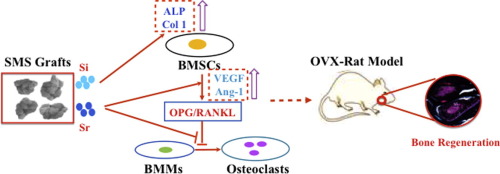Publication date: Available online 12 August 2017
Source:Acta Biomaterialia
Author(s): Lixia Mao, Lunguo Xia, Jiang Chang, Jiaqiang Liu, Lingyong Jiang, Chengtie Wu, Bing Fang
AbstractsBioactive ions released from bioceramics play important roles in bone regeneration; however, it is unclear how each ionic composition in complex bioceramics exerts its specific effect on bone regeneration. The aim of this study is to elucidate the functional effects of Sr and Si ions in bioceramics on the regeneration of osteoporotic bone. A model bioceramic with Sr- and Si-containing components (SMS) was successfully fabricated and the effects of ionic products from SMS bioceramics on the osteogenic, osteoclastic and angiogenic differentiation of rBMSCs-OVX and RANKL-induced osteoclasts were investigated. The results showed that SMS bioceramics could enhance ALP activity and expression of Col 1, OCN, Runx2, and angiogenic factors including VEGF and Ang-1. SMS bioceramics not only rebalanced the OPG/RANKL ratio of rBMSCs-OVX at early stage, but also repressed RANKL-induced osteoclast formation and expression of TRAP, DC-STAMP, V-ATPase a3, and NFATc1. The synergistic effects of Sr and Si ions were further investigated as compared with those of similar concentrations of Sr and Si ions alone. Sr and Si ions possessed synergistic effects on osteogenesis, osteoclastogenesis, and angiogenesis, attributed to the dominant effects of Sr ions on enhancing angiogenesis and repressing osteoclastogenesis, and the dominant effects of Si ions on stimulating osteogenesis. The in vivo study using critical-size mandibular defects of OVX rat models showed that SMS bioceramics could significantly enhance bone formation and mineralization compared with β-TCP bioceramics. Our results are the first to elucidate the specific effect of each ion from bioceramics on osteogenesis, osteoclastogenesis and angiogenesis for osteoporotic bone regeneration, paving the way for the design of functional biomaterials with complex compositions for tissue engineering and regenerative medicine.Statement of significanceBioactive ions released from bioceramics play important roles for bone regeneration; however, it is unclear how each of ionic compositions in complex bioceramics exerts its specific effect on bone regeneration. The aim of present study is to elucidate the functional effects of Sr and Si ions in complex bioceramics on the regeneration of osteoporotic bone. A model bioceramic with Sr and Si-containing components (SMS) was successfully fabricated and the effects of ionic products from SMS bioceramics on the osteogenic, osteoclastic and angiogenic differentiation of rBMSCs-OVX and RANKL-induced osteoclasts were investigated. The results showed that SMS bioceramics could enhance ALP activity and expression of Col 1, OCN, Runx2 and angiogenic factors including VEGF and Ang-1. SMS bioceramics not only rebalanced the ratio of OPG/RANKL of OVX-BMSCs at early stage, but also repressed RANKL-induced osteoclast formation and expression of TRAP, DC-STAMP, V-ATPase a3, and NFATc1. The synergistic effects of Sr and Si ions were further investigated as compared with the similar concentration of Sr and Si ions alone. It was found that Sr and Si ions possessed synergistic effects on osteogenesis, osteoclastogenesis and angiogenesis, attributed to the dominant effects of Sr ions on enhancing angiogenesis and repressing osteoclastogenesis, and the dominant effects of Si ions on stimulating osteogenesis. The in vivo study using critical-size mandibular defects of OVX rat models showed that SMS bioceramics could significantly enhance bone formation and mineralization as compared with β-TCP bioceramics. It is suggested that SMS bioceramics may be a promising biomaterial for osteoporotic bone regeneration.To our knowledge, this is the first time to elucidate the specific effect of each ion from bioceramics on osteogenesis, osteoclastogenesis and angiogenesis for osteoporotic bone regeneration, paving the way to design functional biomaterials with complex compositions for tissue engineering and regenerative medicine.
Graphical abstract

http://ift.tt/2hVaR0u